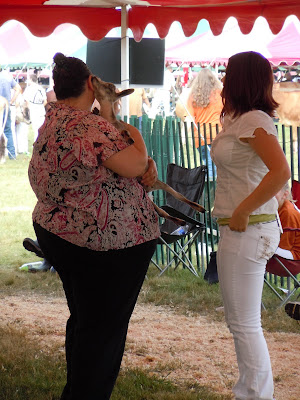Today’s entry came straight from the activity tent at the Junior Livestock Show. The activity tent was filled with fun things for kids to do while they were visiting the show – they could ‘milk’ the fiberglass cow, create their own flowers from a coffee filter and pipe cleaners, color and cut out a 3D barn with barn animal puppets, make butter, discover the history of the Junior Livestock Show (this year was the 63rd show!) and... make homemade ice cream!
History Lesson Time!
Ice cream was favored by the Caliphs of Baghdad. Arabs were the first to use milk as a major ingredient in its production, sweetening the ice cream with sugar rather than fruit juice as early as the 10th century. Today, New Zealanders consume the most ice cream per capita at 27.5 quarts per person, per year! They are followed by Americans, who consume 23 quarts per person, per year. (2007)
Ice cream was favored by the Caliphs of Baghdad. Arabs were the first to use milk as a major ingredient in its production, sweetening the ice cream with sugar rather than fruit juice as early as the 10th century. Today, New Zealanders consume the most ice cream per capita at 27.5 quarts per person, per year! They are followed by Americans, who consume 23 quarts per person, per year. (2007)
It’s actually quite simple to make your own ice cream, if you follow the steps below. The Farmers’ Museum’s lovely and talented Mary Margaret Kuhn will show you how.
Step 1: Gather your ingredients (and your eager assistants!)
To make vanilla ice cream as we did, just follow this recipe:
HOMEMADE VANILLA ICE CREAM
(Did you know that vanilla is the most popular flavor of ice cream? 28% of all ice cream purchased in supermarkets is vanilla!)
(Did you know that vanilla is the most popular flavor of ice cream? 28% of all ice cream purchased in supermarkets is vanilla!)
1 Cup heavy whipping cream
1 and 1/2 Cups Half and Half
3/4 Cups sugar
1 teaspoon vanilla extract
1 pinch salt
Ice cubes
1-2 Cups Kosher salt
2 Plastic ice cream “globes”, (you can also use a 1b coffee can to pour all the ingredients into and duct tape it shut, and put it into a 3 lb coffee can, and pack the ice cubes and Kosher salt around it to achieve the same results)
Step 2: Pour heavy cream, half and half, sugar, vanilla, and pinch of salt into the smaller part of plastic globe (or 1 lb. coffee can)
Step 3: Pack in the ice cubes and kosher salt tightly all around the smaller part of the plastic globe (or in the 3 lb. coffee can)
Step 4: Roll it! If you have many eager assistants as we did, have them sit in a circle with plenty of space between each other. Roll the globes back and forth. (Or 3 lb. coffee can, also sealed with duct tape) Pretend it’s a hot potato and pass it by rolling it as fast as you can! Sing songs with ‘rolling’ as the theme. (Like ‘Proud Mary’) Roll the globes for 15 minutes or longer. (With coffee cans, it’s advised that after 15 minutes, you open the larger can and dump out the ice and water. Open the smaller can and stir the ingredients. Then reseal and repack the cans. Roll for 10 more minutes.)
Step 5: Open the globes, (or smaller coffee can) serve and enjoy! Don’t forget to thank a cow!
For other ice cream flavors, go to this website.




























